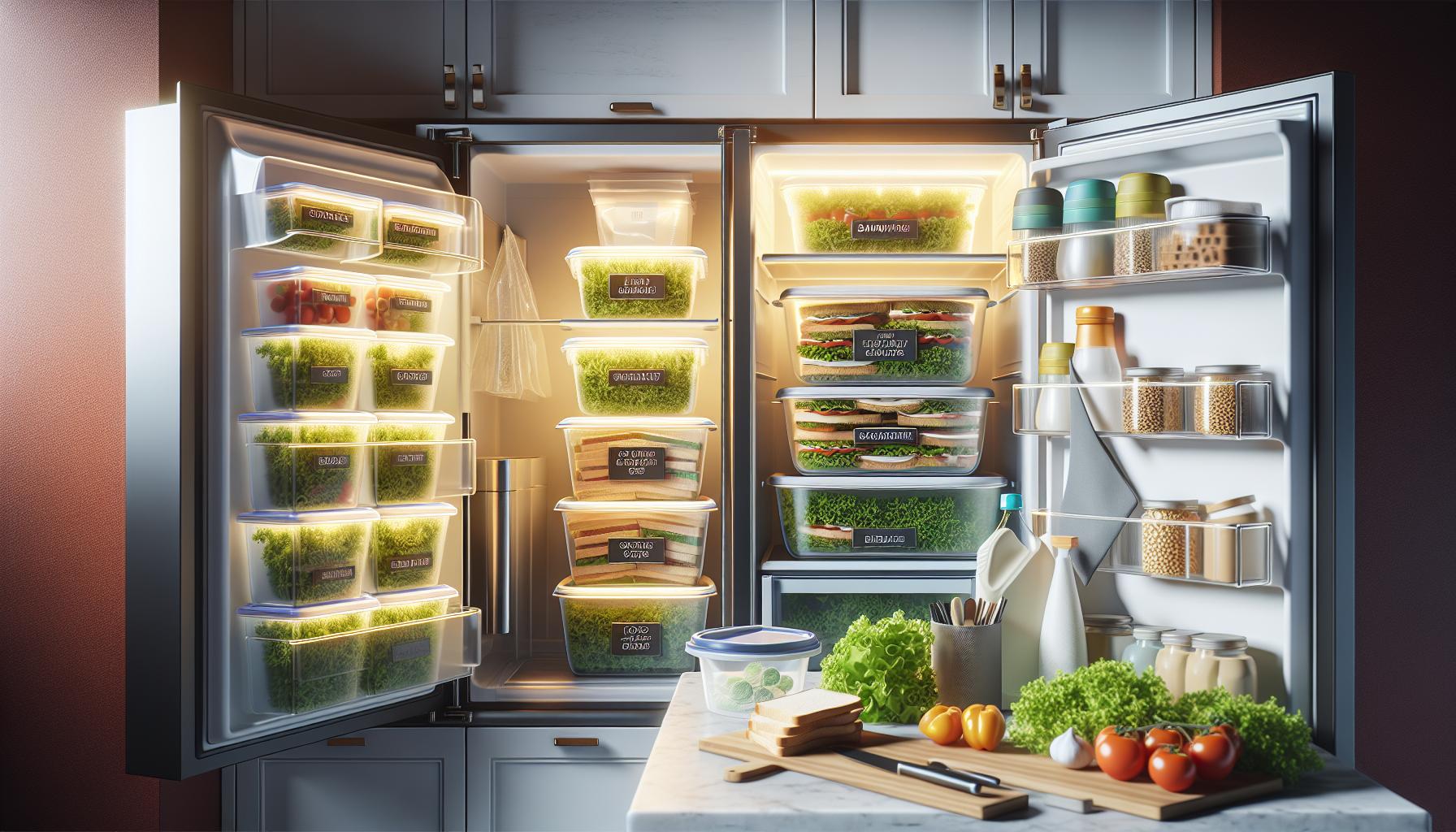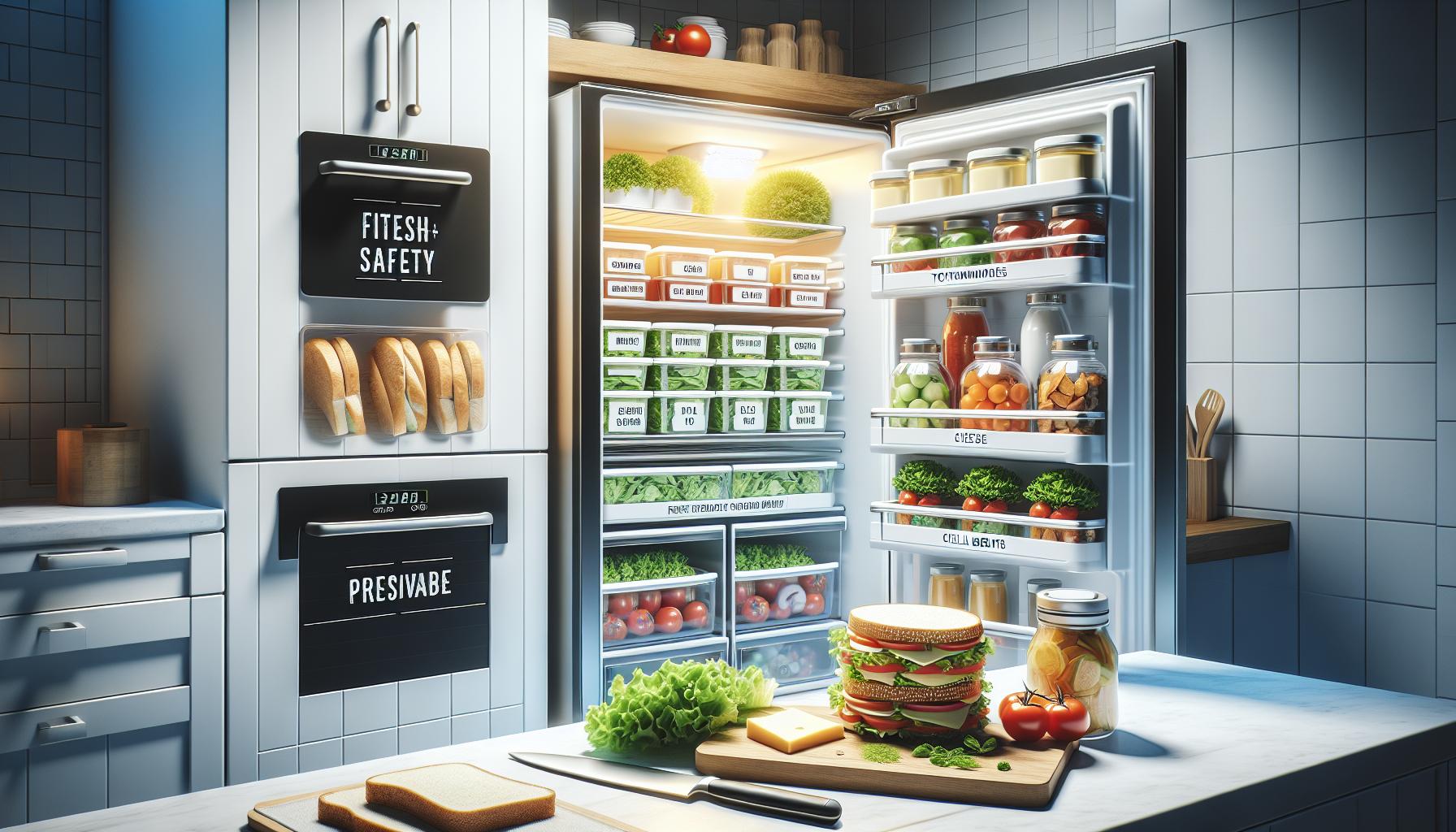Did you know that a well-stored sandwich can be safe and tasty for up to five days in the fridge? With busy schedules and leftover lunches, understanding how long your sandwiches can last is essential for both food safety and flavor. It’s not just about avoiding waste; it’s about ensuring you enjoy every bite of your lunchtime creation.
Many people worry about food spoilage, and sandwiches are often a common culprit-improperly stored, they can become soggy or even unsafe to eat. By learning the right techniques for keeping your sandwiches fresh longer, you can enjoy the convenience of ready-to-eat meals without the risk. Ready to discover best practices in sandwich storage? Let’s dive in and keep your lunch enjoyable and worry-free!
How Long Can You Keep Sandwiches in the Fridge?
When it comes to enjoying sandwiches while ensuring food safety, understanding how long they can last in the fridge is essential. Generally, sandwiches can be kept in the refrigerator for about 3 to 5 days. This timeframe applies as long as they are stored correctly in a sealed container or tightly wrapped. Factors such as the ingredients used, the temperature of your fridge, and how the sandwich was prepared can all influence freshness.
Factors That Affect Sandwich Freshness
The ingredients in your sandwich play a significant role in how long it will last. For instance, sandwiches made with high-moisture ingredients like tomatoes or pickles might spoil faster than those with drier fillings like peanut butter. Additionally, the type of bread can also affect longevity; hearty bread such as sourdough or whole grain tends to stay fresh longer than lighter breads. It’s crucial to keep your refrigerator at a consistent temperature below 40°F (4°C) to maintain the quality of perishable items.
To maximize the shelf life of your sandwiches, consider the following practices:
- Store sandwiches promptly after preparation to minimize exposure to bacteria.
- Keep cold ingredients, such as meats and cheeses, chilled in the fridge until assembly.
- If possible, keep wet ingredients separate until you’re ready to eat, which can help prevent sogginess and spoilage.
By following these guidelines, you can enjoy your sandwiches longer and reduce the risk of foodborne illnesses.
Factors That Affect Sandwich Freshness
The longevity of your sandwich in the fridge depends on several key factors, primarily related to the ingredients and how they are combined. Certain fillings, especially those with high moisture content like tomatoes or cucumbers, can create an environment for rapid spoilage by introducing moisture that promotes bacterial growth. Conversely, drier ingredients, such as hard cheeses or cured meats, typically have a longer shelf life, making them more suitable for extended storage in a refrigerator.
Additionally, the type of bread matters significantly. Artisanal loaves, such as sourdough or whole grain, often contain natural preservatives and have lower moisture levels, allowing them to resist spoilage better than their white bread counterparts. The temperature of your refrigerator is also critical; maintaining a consistent temperature below 40°F (4°C) ensures that perishable items remain safe and, ideally, fresh for longer periods. Fluctuating temperatures can lead to condensation within packaging, which contributes to spoilage.
When preparing your sandwiches, timing is essential. It’s best to store them as soon as they are made to minimize exposure to bacteria. Keep ingredients stored separately until needed; for example, adding lettuce or tomatoes just before consumption can prevent sogginess and help retain freshness. By thoughtfully considering the elements that contribute to sandwich freshness, you can significantly extend their shelf life while enjoying safe and nutritious meals.
Best Practices for Storing Sandwiches Safely
Storing sandwiches properly can greatly extend their shelf life and ensure that they remain appetizing and safe to eat. The first rule of thumb is to cool your sandwiches promptly after preparation and store them in the refrigerator within two hours. Ideally, sandwiches should be consumed within 3 to 5 days of refrigeration, depending on the ingredients used.
To keep your sandwiches as fresh as possible, consider the following best practices:
- Wrap Effectively: Use plastic wrap, aluminum foil, or airtight containers to minimize exposure to air. Wrapping tightly helps prevent moisture loss and keeps your sandwich ingredients from drying out.
- Separate Wet and Dry Ingredients: Ingredients that contain moisture, like tomatoes or mayonnaise, should be added just before eating to prevent mushiness. Consider packing condiments separately in small containers.
- Label and Date: If you are making multiple sandwiches or prepping for the week, label them with the date they were made. This will help you keep track of freshness and avoid eating anything that may have gone bad.
- Store in the Right Location: Keep your sandwiches on a refrigerator shelf, rather than in the door, where temperatures fluctuate more. A consistent temperature below 40°F (4°C) is essential for food safety.
By implementing these storage strategies, you can enjoy sandwiches that taste fresh and are safe to consume throughout the week. Always inspect your sandwiches before eating; if they have an off smell or unusual texture, it’s best to discard them. Following these guidelines will help you make the most of your sandwich preparations while ensuring food safety is a top priority.
Choosing Ingredients That Last Longer
Choosing the right ingredients is crucial for creating sandwiches that not only taste great but also last longer in the fridge. By selecting ingredients with a longer shelf life, you can significantly extend the freshness of your sandwiches, making them more convenient for meal prep and easy lunch options throughout the week.
When selecting proteins, consider using cured meats like salami or prosciutto, which can last up to 1-2 weeks in the refrigerator. These meats also impart rich flavors that enhance your sandwich. If you’re opting for chicken or turkey, choose rotisserie chicken or cooked turkey breast, and consume the sandwich within 3-5 days for optimal freshness. For vegetarian options, hard cheeses like aged cheddar or gouda resist spoilage longer than softer cheeses, making them excellent choices.
The type of bread also plays a significant role in a sandwich’s longevity. Whole grain or sourdough breads tend to contain fewer preservatives than white bread, which can lead to faster spoilage. However, sourdough varieties contain acids that can help inhibit mold growth. Additionally, consider adding sturdy vegetables such as cucumbers, bell peppers, or carrots, which hold up better over time compared to tomatoes or leafy greens that may wilt or release moisture.
To maximize the freshness of your sandwiches, ensure you choose condiments wisely. Opt for mustard or pesto instead of mayonnaise, as they do not spoil as quickly and can enhance the flavor without compromising the sandwich’s integrity. If mayonnaise is a must, consider adding it just before eating to maintain the texture and prevent sogginess. Incorporating these ingredient choices not only allows for tasty and varied sandwiches but also encourages safer food practices in terms of storage and consumption.
How to Wrap Sandwiches for Maximum Freshness
To maintain the freshness and flavor of your sandwiches, proper wrapping techniques are essential. A well-wrapped sandwich not only helps in preserving its taste and texture but also minimizes the risk of contamination and spoilage. When considering how to wrap your sandwiches, the goal is to create a barrier that protects the sandwich from air and moisture while preventing sogginess.
Choose the Right Materials
One of the best options for wrapping sandwiches is plastic wrap, which creates an airtight seal. Make sure to wrap the sandwich tightly to eliminate any trapped air. If you prefer a more eco-friendly alternative, wax paper or parchment paper can also be effective, especially for sandwiches with drier ingredients. These materials allow some breathability while still providing adequate protection. However, avoid wrapping sandwiches in foil for long-term storage; while it can keep them fresh for short periods, it does not prevent moisture from escaping, which can lead to a stale sandwich.
- Plastic Wrap: Ideal for airtight protection.
- Wax Paper: Good balance of breathability and moisture retention.
- Parchment Paper: Non-stick surface, great for drier sandwiches.
Layering for Protection
When wrapping, consider the order of your ingredients. Placing your condiments between layers, like between meats and vegetables, can help prevent the bread from getting soggy. Additionally, try to keep delicate ingredients like lettuce and tomatoes separated from the bread. You can achieve this by using sturdy ingredients or by placing a piece of wax paper over the bread before adding juicy toppings. This extra layer acts as a moisture barrier, extending the sandwich’s freshness.
Storage Considerations
After wrapping, place your sandwich in a container or a resealable plastic bag for additional protection, especially if you’re transporting it. Label the container with the date of preparation to keep track of its shelf life. Generally, sandwiches can be stored in the fridge for 3 to 5 days depending on the ingredients used, so being mindful of how they’re wrapped can significantly help in maximizing their lifespan.
By following these simple wrapping techniques, you can enjoy your sandwiches at their freshest, rich with flavors and safe for consumption throughout the week. Remember, the better you wrap and store, the more enjoyable your lunchtime experience will be.
Signs Your Sandwich Has Gone Bad
When it comes to food safety, being able to recognize the signs of spoilage can save you from unintentional health risks. No one wants to bite into a sandwich only to discover it’s past its prime. Several telltale signs can indicate that your sandwich has gone bad, helping you make informed decisions about your meal.
One of the most obvious indicators of spoilage is a change in smell. If your sandwich emits an off or sour odor, it’s best to err on the side of caution and discard it. Visual cues are also crucial; look for discoloration in the bread or fillings. Bread that has turned green or brown may be developing mold, while ingredients should appear fresh and colorful. Additionally, a slimy or unusually sticky texture, particularly with proteins like deli meats, is another sign that the sandwich is no longer safe to consume.
Your senses play a vital role in evaluating your sandwich’s freshness. Whenever possible, give your sandwich a thorough inspection before eating. If it appears limp or excessively soggy, especially if it has been in the fridge for longer than a few days, it’s time to consider throwing it away. The general guideline for safely consuming sandwiches is within 3 to 5 days of preparation, depending on the ingredients. If you’re ever uncertain, it’s better to prioritize safety over curiosity.
For those who are particularly food-conscious, keeping a close eye on expiration dates of individual sandwich components can be beneficial. Pre-packaged elements like meats and cheeses often have a shelf life that can affect the overall freshness of your sandwich. Always remember, when in doubt, it’s safer to discard it rather than risk foodborne illness. Being knowledgeable about these signs will empower you to keep your lunchtime choices both safe and enjoyable.
Creative Ways to Revive Stale Sandwiches
Reviving stale sandwiches doesn’t just save food; it can breathe new life into a meal that might otherwise end up in the trash. Instead of giving in to the belief that a once-fresh sandwich is destined for disposal, consider these creative approaches to refresh and enjoy those leftovers.
One effective method is to crisp up the bread. If the sandwich features a hard crust, you can warm it in an oven or toaster oven for a few minutes. This not only restores some crunch but also enhances the flavors as the ingredients heat up. Alternatively, for sandwiches that don’t contain mayonnaise, try grilling or toasting them. A light brush of olive oil on the outside can create a delightful golden-brown crust that adds texture and flavor.
Another strategy involves enhancing the fillings. Adding fresh ingredients can significantly improve the taste. Consider slicing up some fresh tomatoes, lettuce, or pickles, or spread a thin layer of a flavorful condiment, like pesto or aioli, to elevate the overall profile of the sandwich. If your sandwich initially incorporated ingredients like turkey or chicken, consider shredding or dicing the meat and blending it into a new dish, such as a salad or a wrap, alongside fresh greens and a tasty dressing.
If all else fails, get creative! Think about transforming that stale sandwich into a casserole. Breaking the sandwich apart and layering it with cheese and a little broth can create a warm, comforting dish that utilizes every part of your meal. This is particularly effective with grilled cheese or any sandwich with melted cheese.
In summary, stale sandwiches can transform into new culinary delights with a little creativity and effort. Whether reheating to restore a crispy texture, enhancing flavors with fresh ingredients, or repurposing them into casseroles, these methods can turn potential waste into delicious meals while also practicing good food safety. Always ensure that any ingredients you add are fresh and safe to consume, maintaining the integrity of your food choices.
Can You Freeze Sandwiches for Longer Storage?
Freezing sandwiches can be an excellent way to extend their shelf life while maintaining flavor and texture, but not all sandwiches are suitable for freezing. When freezing, the key is to consider the ingredients used and how they work together when thawed. Most sandwiches can be frozen for up to three months without significant loss in quality. However, some ingredients like mayonnaise, lettuce, and tomatoes tend to become watery or mushy once thawed. To ensure your sandwiches taste fresh when taken out of the freezer, it’s best to stick with sturdier components like deli meats, cheeses, and spreads like mustard or hummus that withstand freezing better.
To properly freeze sandwiches, start by assembling your sandwich and then wrapping it tightly. Use plastic wrap or aluminum foil to cover it completely, ensuring no air pockets can form. You can also place the wrapped sandwich in a freezer-safe bag for added protection against freezer burn. Label the bag with the date so you can keep track of how long it has been stored. For optimal convenience, consider freezing sandwiches in individual portions to make it easier to grab a quick meal on busy days.
When you’re ready to eat, there are two effective methods for thawing frozen sandwiches. You can either place the sandwich in the refrigerator overnight or use the microwave for quick defrosting. If opting for the microwave, unwrap the sandwich and heat it in short bursts, flipping it to ensure even thawing. After defrosting, you can toast the sandwich in a skillet or sandwich press for added crispness, revitalizing it as if it were freshly made.
Common Sandwich Ingredients and Their Shelf Life
Understanding the shelf life of common sandwich ingredients is essential for maintaining food safety and ensuring that your meals remain fresh and enjoyable. Different components can have varying storage durations, and knowing these can help you make informed choices when preparing your sandwiches.
Fresh meats, for example, typically last about 3 to 5 days in the refrigerator when properly stored. Deli meats, if sealed and stored correctly, can often last a bit longer, around 5 to 7 days after opening. It’s important to keep deli meats tightly wrapped to prevent them from drying out or absorbing odors from other foods. As for cheeses, hard cheeses can last up to 3 to 4 weeks in the fridge, while softer cheeses like cream cheese have a shorter lifespan of about 1 to 2 weeks after opening.
Vegetables and condiments play a significant role in sandwich freshness as well. Leafy greens such as lettuce typically stay fresh for about 3 to 7 days, but coated with moisture, they can spoil quickly. Tomatoes, however, should be added just before eating as they can make other ingredients soggy and only last for a couple of days in a sandwich. For condiments, mustard and mayonnaise can last quite a long time-generally up to 3 months in the refrigerator once opened-making them a reliable choice for enhancing flavor without the risk of spoiling quickly.
To assist with this, here’s a quick reference table for common sandwich ingredients and their shelf lives:
| Ingredient | Shelf Life in Fridge |
|---|---|
| Fresh Deli Meats | 3 to 5 days |
| Hard Cheeses | 3 to 4 weeks |
| Soft Cheeses | 1 to 2 weeks |
| Lettuce | 3 to 7 days |
| Tomatoes | 1 to 2 days (after slicing) |
| Mustard | 3 months |
| Mayonnaise | 3 months |
By keeping track of these storage times, you can optimize the freshness of your sandwiches and minimize food waste. Proper handling, such as keeping ingredients cool and sealed, is key to ensuring they last as long as possible.
Myths About Sandwich Storage Debunked
There’s a misconception that all sandwiches can stay fresh in the fridge for a week or more, but this simply isn’t true. While some ingredients do have longer shelf lives, others can lead to hurried spoilage if not stored properly. For instance, fresh vegetables can significantly diminish the lifespan of bread if they’re not used quickly. Generally, lettuce and tomato can start to deteriorate in just a few days, especially if moisture accumulates. Thus, packing them separately or adding them just before consumption can enhance overall sandwich longevity.
Another common myth is that if a sandwich looks fine, it’s safe to eat. This can be misleading. Bacteria that cause foodborne illnesses can proliferate without visible signs of spoilage. It’s crucial to adhere to the general rule of consuming pre-made sandwiches within 3 to 5 days, depending on the fillings. If you’re unsure whether a sandwich is safe, trust your senses-if it smells off or has an unusual texture, it’s best to discard it.
Many believe that storing sandwiches in airtight containers is always the best approach, but this isn’t a one-size-fits-all solution. While airtight containers can keep sandwiches fresh, some ingredients, like leafy greens, can become wilted or soggy due to trapped moisture. Instead, using parchment paper or wrapping the sandwich loosely in foil can provide better air circulation while keeping the sandwich intact.
When it comes to freezing sandwiches, myths abound regarding their texture and taste after thawing. Contrary to popular belief, not all sandwiches freeze well. While fillings like peanut butter and jelly or certain cheeses fare better, those with moisture-rich ingredients may suffer from a mushy texture once thawed. Thus, it’s essential to choose your ingredients wisely if you plan to freeze sandwiches, ensuring both safety and desirability later on.
Tips to Keep Your Lunch Fresh All Week
To ensure your sandwiches remain fresh throughout the week, it’s essential to adopt mindful storage practices from the moment you prepare them. While refrigerating your sandwiches can extend their shelf life, proper handling and ingredient choices make a significant difference. Sandwiches should ideally be consumed within 3 to 5 days, but with the right techniques, you can keep them enjoyable for every day of the week.
One effective strategy is to use the right ingredients. Opt for fillings that have a longer shelf life, such as hard cheeses, cured meats, and hearty vegetables like bell peppers and cucumbers, rather than ingredients high in moisture, such as tomatoes and lettuce. Incorporating spreads like mustard or hummus can help preserve moisture balance. Additionally, consider adding ingredients that enhance flavor but don’t spoil quickly, such as pickles or olives.
Smart Packing Techniques
How you wrap your sandwiches is as crucial as the ingredients. Instead of conventional plastic wrap, which traps moisture, consider using parchment paper or foil. These materials allow for a bit of air circulation, preventing sogginess. If you’re preparing multiple sandwiches for the week, a bento box or a sandwich container with compartments can be a clever way to keep everything organized and fresh, allowing you to separate wet and dry ingredients until mealtime.
Lastly, remember to refrigerate your sandwiches promptly after making them. Store them in a consistent cold environment in the fridge, ideally at or below 40°F (4°C), to prevent any bacterial growth. Labeling your sandwiches with the date of preparation also helps you keep track of freshness and consume them within the safe timeframe. By implementing these strategies, you can enjoy delicious and fresh sandwiches all week long, minimizing waste and maximizing flavor.
The Best Containers for Storing Sandwiches
Choosing the right container can significantly influence the longevity and freshness of your sandwiches. Proper storage not only keeps your lunch appealing but also minimizes the risk of bacterial growth. Ideal containers should provide a balance of air circulation and moisture retention. Here are some container options to ensure your sandwiches stay delicious throughout the week.
First, look for airtight containers made from BPA-free plastic or glass. These offer a tight seal to keep your sandwiches fresh while preventing contaminants. Glass containers are particularly beneficial as they don’t retain odors and can withstand temperature changes if you decide to heat your sandwich. For a compact option, consider using bento boxes, which often include compartments. This allows you to separate wet ingredients like pickles or tomatoes until meal time, preserving the integrity of your sandwich.
Another effective choice is reusable silicone bags. They are flexible, easy to clean, and can conform to the shape of your sandwich, reducing the risk of squishing. These bags can also be laid flat in the fridge, optimizing storage space. For those who prefer a traditional approach, using parchment paper for wrapping, and then placing wrapped sandwiches in a breathable cloth bag can be an eco-friendly option. This method allows for some air circulation, helping to prevent sogginess.
Make sure to label your containers with the date of preparation. This simple step helps you track freshness and ensures that you consume your sandwiches within the recommended 3 to 5 days. Over time, the right storage solution will not only keep your lunches safe but will also enhance your enjoyment of each flavorful bite.
Faq
Q: How can I tell if a sandwich is still good to eat?
A: To determine if a sandwich is still safe to eat, check for signs of spoilage such as an off smell, unusual color, or slimy texture. If these signs are present, it’s best to discard the sandwich. Consult the “Signs Your Sandwich Has Gone Bad” section for more details.
Q: What types of sandwiches last the longest in the fridge?
A: Sandwiches made with durable ingredients, such as cured meats, hard cheeses, and certain vegetables like pickles, typically last longer. They are less prone to spoilage compared to sandwiches with fresh meats or delicate greens. For more tips, refer to “Choosing Ingredients That Last Longer.”
Q: Can I store sandwiches in aluminum foil instead of plastic wrap?
A: Yes, aluminum foil can effectively protect sandwiches from air exposure and moisture. However, it may not seal as tightly as plastic wrap, so ensure the foil is well-wrapped. For optimal freshness, check the “How to Wrap Sandwiches for Maximum Freshness” section.
Q: How long can I keep sandwich spreads in the fridge?
A: Most sandwich spreads, such as mayonnaise and mustard, can last for about 2-3 months once opened if stored properly in the refrigerator. Always check for changes in smell or consistency before use. For specific storage tips, see the “Common Sandwich Ingredients and Their Shelf Life” section.
Q: What should I avoid putting in a sandwich for longer storage?
A: Avoid using ingredients that spoil quickly, like fresh tomatoes and lettuce, or high-moisture spreads, as they can make the bread soggy and promote spoilage. For better ingredient choices, refer to “Choosing Ingredients That Last Longer.”
Q: Is it safe to eat a sandwich that was left out for a few hours?
A: If a sandwich has been left out at room temperature for more than two hours, it should be discarded to avoid foodborne illness. Always follow food safety guidelines as outlined in the “Best Practices for Storing Sandwiches Safely” section.
Q: How can I revive a stale sandwich?
A: To revive a stale sandwich, you can lightly toast it in an oven or pan to refresh the bread’s texture. Additionally, adding fresh toppings like lettuce or tomato can enhance flavor. For more ideas, see “Creative Ways to Revive Stale Sandwiches.”
Q: What are the best containers for storing sandwiches?
A: Airtight containers or reusable sandwich bags are ideal for storing sandwiches because they prevent air exposure and moisture loss. For more options, consider the “The Best Containers for Storing Sandwiches” section.
In Retrospect
Now that you know how to keep your sandwiches fresh in the fridge, put this knowledge to work and enjoy delicious, safe lunches every day! Remember, most sandwiches can last up to three to four days in the refrigerator when stored properly in an airtight container. Don’t forget to check out our tips on how to extend shelf life with proper packing techniques and ingredients. For more delicious ideas, explore our easy-to-make Tomato Sandwich recipe or get creative with a Loaded Egg Salad Sandwich that varies with each preparation!
If you found this guide helpful, consider subscribing to our newsletter for more tips on food preservation and exciting recipes directly to your inbox. Got questions or want to share your sandwich storage hacks? Leave a comment below! Your input makes our community stronger, and we love hearing from you. Dive deeper into the world of meal prepping and discover how to make your leftovers work harder for you, ensuring that every meal is as delightful as it can be!





